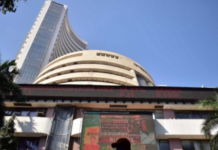MUMBAI — Indian equity benchmarks closed lower on Friday, capping the week with broad-based losses as investors booked profits across most sectors amid weak global cues and cautious sentiment.
The Sensex declined 466.75 points, or 0.55 percent, to settle at 83,938.71, while the Nifty fell 155.75 points, or 0.60 percent, to close at 25,722.10.
Analysts said the price action indicated that bullish momentum had weakened in the short term but noted that the broader market structure remains positive as long as the Nifty stays above 25,660. “A decisive close below this level could trigger further downside toward 25,400–25,250,” analysts observed. “Conversely, a rebound and sustained move above 26,000 will likely reestablish bullish momentum, paving the way for a move toward 26,150–26,300.”
Losses were seen across the board, with most Sensex components ending in the red. Only a few heavyweights — including BEL, Larsen & Toubro, TCS, ITC, and State Bank of India — managed to stay positive.
Among the major laggards, NTPC, Kotak Mahindra Bank, Bajaj Finserv, ICICI Bank, and HDFC Bank fell sharply, with declines of up to 3.45 percent.
The weakness extended to the broader markets as well. The Nifty Midcap 100 index slipped 0.45 percent, and the Nifty Smallcap 100 dropped 0.48 percent.
Among sectoral indices, only Nifty PSU Bank and Nifty Oil & Gas posted gains — up 1.5 percent and 0.07 percent, respectively. All other indices ended lower, with Nifty Metal and Nifty Media falling more than 1 percent each, emerging as the worst performers.
Market participants attributed the decline to profit-booking and a cautious global environment. “Indian equities ended decisively lower after a volatile session as investors booked profits amid mixed corporate earnings and cautious global sentiment in the backdrop of a strong greenback,” market watchers said.
They added that renewed foreign institutional investor (FII) selling followed Federal Reserve Chair Jerome Powell’s hawkish remarks and disappointing U.S.-China trade developments.
Despite the pullback, analysts maintained that “buy on dips” remains the preferred trading strategy, citing continued optimism on a quarter-on-quarter basis. (Source: IANS)













